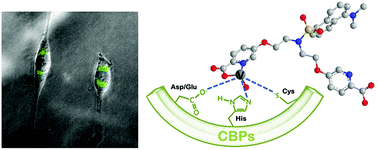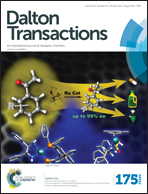Vanadyl complexes with dansyl-labelled di-picolinic acid ligands: synthesis, phosphatase inhibition activity and cellular uptake studies†
Abstract
Vanadium complexes have been previously utilised as potent inhibitors of cysteine based phosphatases (CBPs). Herein, we present the synthesis and characterisation of two new fluorescently labelled vanadyl complexes (14 and 15) with bridged di-picolinic acid ligands. These compounds differ significantly from previous vanadyl complexes with phosphatase inhibition properties in that the metal-chelating part is a single tetradentate unit, which should afford greater stability and scope for synthetic elaboration than the earlier complexes. These new complexes inhibit a selection of cysteine based phosphatases (CBPs) in the nM range with some selectivity. Fluorescence spectroscopic studies (including fluorescence anisotropy) were carried out to demonstrate that the complexes are not simply acting as vanadyl delivery vehicles but they interact with the proteins. Finally, we present preliminary fluorescence microscopy studies to demonstrate that the complexes are cell permeable and localise throughout the cytoplasm of NIH3T3 cells.


 Please wait while we load your content...
Please wait while we load your content...